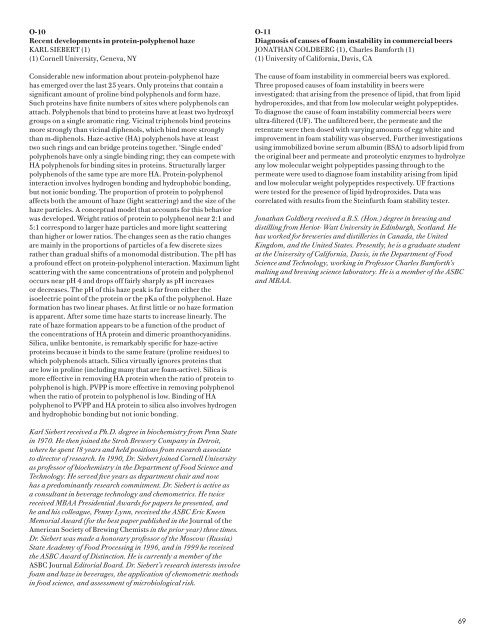Program Book - Master Brewers Association of the Americas
Program Book - Master Brewers Association of the Americas
Program Book - Master Brewers Association of the Americas
Create successful ePaper yourself
Turn your PDF publications into a flip-book with our unique Google optimized e-Paper software.
O-10<br />
Recent developments in protein-polyphenol haze<br />
KARL SIEBERT (1)<br />
(1) Cornell University, Geneva, NY<br />
Considerable new information about protein-polyphenol haze<br />
has emerged over <strong>the</strong> last 25 years. Only proteins that contain a<br />
significant amount <strong>of</strong> proline bind polyphenols and form haze.<br />
Such proteins have finite numbers <strong>of</strong> sites where polyphenols can<br />
attach. Polyphenols that bind to proteins have at least two hydroxyl<br />
groups on a single aromatic ring. Vicinal triphenols bind proteins<br />
more strongly than vicinal diphenols, which bind more strongly<br />
than m-diphenols. Haze-active (HA) polyphenols have at least<br />
two such rings and can bridge proteins toge<strong>the</strong>r. ‘Single ended’<br />
polyphenols have only a single binding ring; <strong>the</strong>y can compete with<br />
HA polyphenols for binding sites in proteins. Structurally larger<br />
polyphenols <strong>of</strong> <strong>the</strong> same type are more HA. Protein-polyphenol<br />
interaction involves hydrogen bonding and hydrophobic bonding,<br />
but not ionic bonding. The proportion <strong>of</strong> protein to polyphenol<br />
affects both <strong>the</strong> amount <strong>of</strong> haze (light scattering) and <strong>the</strong> size <strong>of</strong> <strong>the</strong><br />
haze particles. A conceptual model that accounts for this behavior<br />
was developed. Weight ratios <strong>of</strong> protein to polyphenol near 2:1 and<br />
5:1 correspond to larger haze particles and more light scattering<br />
than higher or lower ratios. The changes seen as <strong>the</strong> ratio changes<br />
are mainly in <strong>the</strong> proportions <strong>of</strong> particles <strong>of</strong> a few discrete sizes<br />
ra<strong>the</strong>r than gradual shifts <strong>of</strong> a monomodal distribution. The pH has<br />
a pr<strong>of</strong>ound effect on protein-polyphenol interaction. Maximum light<br />
scattering with <strong>the</strong> same concentrations <strong>of</strong> protein and polyphenol<br />
occurs near pH 4 and drops <strong>of</strong>f fairly sharply as pH increases<br />
or decreases. The pH <strong>of</strong> this haze peak is far from ei<strong>the</strong>r <strong>the</strong><br />
isoelectric point <strong>of</strong> <strong>the</strong> protein or <strong>the</strong> pKa <strong>of</strong> <strong>the</strong> polyphenol. Haze<br />
formation has two linear phases. At first little or no haze formation<br />
is apparent. After some time haze starts to increase linearly. The<br />
rate <strong>of</strong> haze formation appears to be a function <strong>of</strong> <strong>the</strong> product <strong>of</strong><br />
<strong>the</strong> concentrations <strong>of</strong> HA protein and dimeric proanthocyanidins.<br />
Silica, unlike bentonite, is remarkably specific for haze-active<br />
proteins because it binds to <strong>the</strong> same feature (proline residues) to<br />
which polyphenols attach. Silica virtually ignores proteins that<br />
are low in proline (including many that are foam-active). Silica is<br />
more effective in removing HA protein when <strong>the</strong> ratio <strong>of</strong> protein to<br />
polyphenol is high. PVPP is more effective in removing polyphenol<br />
when <strong>the</strong> ratio <strong>of</strong> protein to polyphenol is low. Binding <strong>of</strong> HA<br />
polyphenol to PVPP and HA protein to silica also involves hydrogen<br />
and hydrophobic bonding but not ionic bonding.<br />
Karl Siebert received a Ph.D. degree in biochemistry from Penn State<br />
in 1970. He <strong>the</strong>n joined <strong>the</strong> Stroh Brewery Company in Detroit,<br />
where he spent 18 years and held positions from research associate<br />
to director <strong>of</strong> research. In 1990, Dr. Siebert joined Cornell University<br />
as pr<strong>of</strong>essor <strong>of</strong> biochemistry in <strong>the</strong> Department <strong>of</strong> Food Science and<br />
Technology. He served five years as department chair and now<br />
has a predominantly research commitment. Dr. Siebert is active as<br />
a consultant in beverage technology and chemometrics. He twice<br />
received MBAA Presidential Awards for papers he presented, and<br />
he and his colleague, Penny Lynn, received <strong>the</strong> ASBC Eric Kneen<br />
Memorial Award (for <strong>the</strong> best paper published in <strong>the</strong> Journal <strong>of</strong> <strong>the</strong><br />
American Society <strong>of</strong> Brewing Chemists in <strong>the</strong> prior year) three times.<br />
Dr. Siebert was made a honorary pr<strong>of</strong>essor <strong>of</strong> <strong>the</strong> Moscow (Russia)<br />
State Academy <strong>of</strong> Food Processing in 1996, and in 1999 he received<br />
<strong>the</strong> ASBC Award <strong>of</strong> Distinction. He is currently a member <strong>of</strong> <strong>the</strong><br />
ASBC Journal Editorial Board. Dr. Siebert’s research interests involve<br />
foam and haze in beverages, <strong>the</strong> application <strong>of</strong> chemometric methods<br />
in food science, and assessment <strong>of</strong> microbiological risk.<br />
O-11<br />
Diagnosis <strong>of</strong> causes <strong>of</strong> foam instability in commercial beers<br />
JONATHAN GOLDBERG (1), Charles Bamforth (1)<br />
(1) University <strong>of</strong> California, Davis, CA<br />
The cause <strong>of</strong> foam instability in commercial beers was explored.<br />
Three proposed causes <strong>of</strong> foam instability in beers were<br />
investigated: that arising from <strong>the</strong> presence <strong>of</strong> lipid, that from lipid<br />
hydroperoxides, and that from low molecular weight polypeptides.<br />
To diagnose <strong>the</strong> cause <strong>of</strong> foam instability commercial beers were<br />
ultra-filtered (UF). The unfiltered beer, <strong>the</strong> permeate and <strong>the</strong><br />
retentate were <strong>the</strong>n dosed with varying amounts <strong>of</strong> egg white and<br />
improvement in foam stability was observed. Fur<strong>the</strong>r investigations<br />
using immobilized bovine serum albumin (BSA) to adsorb lipid from<br />
<strong>the</strong> original beer and permeate and proteolytic enzymes to hydrolyze<br />
any low molecular weight polypeptides passing through to <strong>the</strong><br />
permeate were used to diagnose foam instability arising from lipid<br />
and low molecular weight polypeptides respectively. UF fractions<br />
were tested for <strong>the</strong> presence <strong>of</strong> lipid hydroproxides. Data was<br />
correlated with results from <strong>the</strong> Steinfurth foam stability tester.<br />
Jonathan Goldberg received a B.S. (Hon.) degree in brewing and<br />
distilling from Heriot- Watt University in Edinburgh, Scotland. He<br />
has worked for breweries and distilleries in Canada, <strong>the</strong> United<br />
Kingdom, and <strong>the</strong> United States. Presently, he is a graduate student<br />
at <strong>the</strong> University <strong>of</strong> California, Davis, in <strong>the</strong> Department <strong>of</strong> Food<br />
Science and Technology, working in Pr<strong>of</strong>essor Charles Bamforth’s<br />
malting and brewing science laboratory. He is a member <strong>of</strong> <strong>the</strong> ASBC<br />
and MBAA.<br />
69



